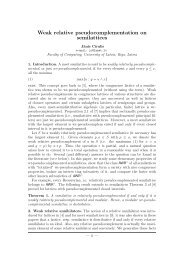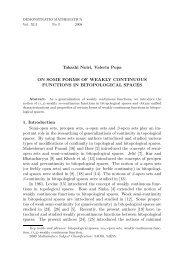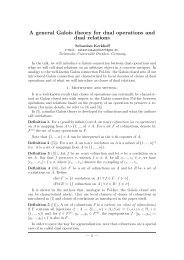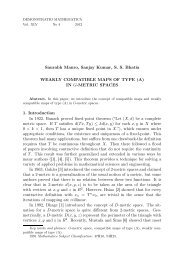Finite segments of the harmonic series
Finite segments of the harmonic series
Finite segments of the harmonic series
You also want an ePaper? Increase the reach of your titles
YUMPU automatically turns print PDFs into web optimized ePapers that Google loves.
Corollary 6. Let a/b ∈ H with (a, b) = 1. Then <strong>the</strong>re is a pair 〈m, k〉<br />
such that b|µ(m, k), and such that µ(m, k)/b = σ(m, k)µ(m, k)/a.<br />
Pro<strong>of</strong>. There exists 〈m, k〉 ∈ N 2 for which 〈a, b〉 = 〈ν(m, k), δ(m, k)〉.<br />
But ν/δ is <strong>the</strong> lowest-terms form <strong>of</strong> <strong>the</strong> rational number σµ/µ. It follows<br />
that µ/b = q = σµ/a for some q ∈ N.<br />
Corollary 7. The integer µ/δ = σµ/ν is a product <strong>of</strong> powers p n <strong>of</strong> odd<br />
primes p ≤ k.<br />
The next result engenders our guess that σ : N 2 → Q + is injective.<br />
Theorem 8. If k ≥ 2 <strong>the</strong>n σ(m, k) ∈ 1/N.<br />
Pro<strong>of</strong>. Pretend <strong>the</strong> <strong>the</strong>orem fails for a given k ≥ 2 and m ≥ 1. That is,<br />
we pretend that σ = 1/δ.<br />
If kδ < m <strong>the</strong>n 1/kδ > 1/m > 1/(m+1) > · · · > 1/(m+k−1), whence<br />
1/δ = k · 1/kδ > 1/m + 1/(m + 1) + · · · + 1/(m + k − 1) =: σ. Similarly, if<br />
kδ > m + k − 1 <strong>the</strong>n 1/δ < σ. Hence m ≤ kδ ≤ m + k − 1 if σ = 1/δ.<br />
From k ≥ 2 we get 1/m < σ = 1/δ. Thus 2 ≤ δ < m. So<br />
kδ ≤ m + k − 1 implies k ≤ k(δ − 1) ≤ m − 1 < m, giving us m > k.<br />
Sylvester’s <strong>the</strong>orem implies that <strong>the</strong>re is a prime p > k and v ∈ N such<br />
that p v ∈ S(m, k). Then p v xp for exactly one xp ∈ [m, m + k), and<br />
(p, x) = 1 for every x ∈ [m, m + k) \ {xp}. Hence (µ/xp, p) = 1, while<br />
p|µ/x for each x ∈ [m, m + k) \ {xp}. So (µσ, p) = 1 while p v µ.<br />
Therefore p v δ, since µσ/µ = 1/δ. We must infer that xp = kδ.<br />
Define σ ′ := σ − 1/kδ = c/d with (c, d) = 1. Then σ ′ = 1/δ − 1/kδ =<br />
(k − 1)/kδ. Now p|kδ, but (k − 1, p) = 1 since p > k. So p|d. On<br />
<strong>the</strong> o<strong>the</strong>r hand, σ ′ = (µσ − µ/kδ)/µ, and p v | (µσ − µ/kδ) since p v µ/x<br />
for every x ∈ [m, m + k) \ {kδ}. Thus, recalling that p v µ we infer that<br />
(p, d) = 1, reaching a contradiction: p|d ∧ (p, d) = 1. So σ = 1/δ.<br />
Notice that Theorem 8 implies that Hn ⊃ Hn+1 for all n ∈ N.<br />
Henceforth fix 〈m, k, m ′ 〉 ∈ N 3 with k ≥ 2 and m ′ ≥ m + k; define<br />
k ′ = min{j : σ(m ′ , j) ≥ σ(m, k)}. Observe that 0 ≤ σ(m ′ , k ′ ) − σ(m, k) <<br />
σ(m ′ , k ′ ) − σ(m ′ , k ′ − 1) = 1/(m ′ + k ′ − 1) ≤ 1/(m + 2k).<br />
Theorem 9. Let m ′ ≤ k ′ . Then σ(m ′ , k ′ ) = σ(m, k).<br />
4








